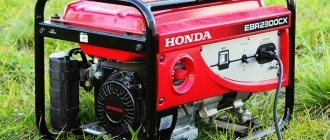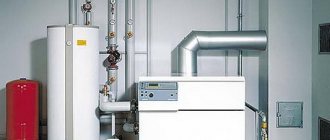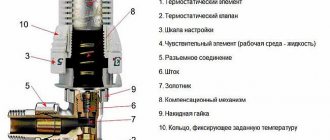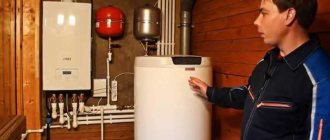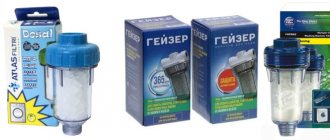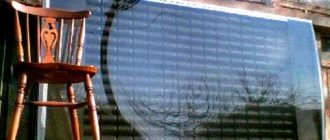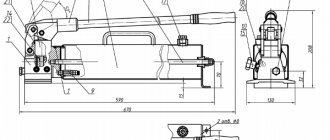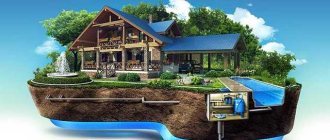The rise in cost of traditional energy sources encourages private home owners to look for alternative options for heating their homes and heating water. Agree, the financial component of the issue will play an important role when choosing a heating system.
One of the most promising methods of energy supply is the conversion of solar radiation. For this purpose, solar systems are used. Understanding the principle of their design and the mechanism of operation, making a solar collector for heating with your own hands will not be difficult.
We will tell you about the design features of solar systems, offer a simple assembly diagram and describe the materials that can be used. The stages of work are accompanied by visual photographs, the material is supplemented by videos about the creation and commissioning of a home-made collector.
The principle of operation of the solar collector
It's very simple. The panels accumulate solar heat and transfer it to the coolant. It circulates through a coil in the storage tank and releases heat to the water, which can be used for any need. The entire process is controlled by a controller, which starts the pump group if the heat exchanger reaches the required temperature.
How does a solar collector work in general?
. The entire system consists of the following elements:
- the panels themselves in the required quantity according to calculations,
- control controller (including sensors),
- pump group,
- storage capacity (usually a tank of 300-3000 liters),
- mounting elements, pipes and fittings.
It is impossible to remove any element from this scheme; it will not work. The only exception is collectors with flow-through heaters. More on them a little later.
Performance you can count on
Before installing such equipment, it is worth considering such a factor as payback. After all, a bad entrepreneur is one who does not make a profit from his investments. The payback of a collector depends directly on its productivity.
Nuances of using collectors for heating or water heating
The number of devices is determined depending on the needs. Solar solar collectors can be combined into groups. The volume and temperature of heated water depend on many factors, including the temperature and weather outside, the amount of water used, and so on. Therefore, the water heating temperature will be different every day.
Note! It is recommended to pour non-toxic antifreeze into solar collectors as a coolant. This will help to use the system in cold conditions and will also extend its service life.
Before buying a collector, you should accurately determine the purpose of use and where it will be located. To choose the right model and quantity.
Absorber, the most important part of the system
The part of the solar collector that receives, accumulates and transfers heat to the coolant is called an absorber. The efficiency of the entire system depends on this element.
This element is made of copper, aluminum or glass, followed by coating. The efficiency of the absorber depends more on the coating than on the material from which it is made. Below, in the photo, you can see what kind of coatings there are and how effectively they can absorb heat.
The description of the system indicates the maximum possible absorption of solar energy incident on the absorber. "α" is the maximum possible absorption percentage. "ε" is the percentage of reflected heat.
By type of structure
Absorbers also differ in the type of device; now there are only two types:
Feather
- are arranged as follows. The plates connect tubes with coolant to each other. The tubes themselves can be interconnected into one system in several ways. This is a simple type of absorber that you can make yourself.
Cylindrical
— in this case, the coating is applied to the glass surface of the flask and used in vacuum manifolds. Thanks to this device, the heat is concentrated more precisely in the center of the tube where the heat extractor, or rod, is located. This system operates with higher efficiency than the pen system.
Size calculation
Calculation of dimensions in order to make a solar collector for heating with your own hands is, first of all, aimed at determining the load of the heating system, the coverage of which is assumed by this device. It goes without saying that this implies the use of several energy sources in combination, and not just solar energy. In this matter, it is important to arrange the system in such a way that it interacts with others - then this will give the maximum effect.
To determine the collector area, you need to know for what purposes it will be used: heating, water heating, or both. By analyzing water meter data, heating needs and insolation data of the area in which installation is planned, the collector area can be calculated. In addition, it is necessary to take into account the hot water needs of all consumers that are planned to be connected to the network: washing machine, dishwasher, etc.
What types of solar collectors are there?
There are two types of such systems: flat and vacuum. But, at their core, their operating principles are similar. They use the sun's heat to heat water. They differ only in the device. Let's look at the operating principles of these types of solar systems in more detail.
Flat
This is the simplest and cheapest type of collector. It works as follows: The metal body, which is internally treated with a highly efficient feather absorber to absorb heat, contains copper tubes. A coolant (water or antifreeze) circulates through them, which absorbs heat. Next, this coolant passes through a heat exchanger in a storage tank, where it transfers heat directly to the water that we can use, for example, to heat a house.
The upper part of the system is covered with high-strength glass. All other sides of the body are insulated with insulation to reduce heat loss.
| Advantages | Flaws |
| Low cost panels | Low efficiency, approximately 20% lower than vacuum |
| Simple design | Large amount of heat loss through the body |
Because of their ease of manufacture, such systems are often made even with their own hands. You can purchase the necessary materials at construction stores.
Vacuum
These systems work a little differently, this is due to their design. The panel consists of double tubes. The outer tube plays a protective role. They are made of high-strength glass. The inner tube has a smaller diameter and is covered with an absorber that accumulates solar heat.
Kinds
The standard device has the form of a metal plate, which is placed in a plastic or glass case. The surface of this plate accumulates solar energy, retains heat and transfers it for various household needs: heating, water heating, etc. Integrated collectors come in several types.
Cumulative
Storage collectors are also called thermosiphon collectors. This DIY solar collector without a pump is the most profitable. Its capabilities allow you not only to heat water, but also to maintain the temperature at the required level for some time.
This solar heating collector consists of several tanks filled with water, which are located in a thermal insulation box. The tanks are covered with a glass lid, through which the sun's rays shine through and heat the water. This option is the most economical, easy to operate and maintain, but its effectiveness in winter is practically zero.
Flat
It is a large metal plate - an absorber, which is located inside an aluminum case with a glass lid. A do-it-yourself flat-plate solar collector will be more efficient if you use a glass cover. Absorbs solar energy through hail-resistant glass, which transmits light well and practically does not reflect it.
There is thermal insulation inside the box, which can significantly reduce heat loss. The wafer itself has low efficiency, so it is coated with an amorphous semiconductor, which significantly increases the thermal energy accumulation rate.
When making a solar collector for a swimming pool with your own hands, preference is often given to a flat integrated device. However, it copes just as well with other tasks, such as heating water for household needs and heating a room. Flat is the most widely used option. It is preferable to make an absorber for a solar collector from copper with your own hands.
Liquid
From the name it is clear that the main coolant in them is liquid. A do-it-yourself water solar collector is made according to the following scheme. Through a metal plate that absorbs solar energy, heat is transferred through pipes attached to it into a tank with water or antifreeze liquid or directly to the consumer.
Two pipes approach the plate. Through one of them, cold water is supplied from the tank, and through the second, already heated liquid enters the tank. Pipes must have inlet and outlet openings. This heating circuit is called closed.
When heated water is directly supplied to meet the needs of the user, such a system is called open-loop.
Non-glazed ones are more often used to heat water in a swimming pool, so assembling such thermal solar collectors with your own hands does not require the purchase of expensive materials - rubber and plastic will do. Glazed ones have higher efficiency, so they are able to heat the house and provide the consumer with hot water.
Air
Air devices are more economical than the above-mentioned analogs that use water as a coolant.
The air does not freeze, does not leak, and does not boil like water. If a leak occurs in such a system, it does not cause as many problems, but it is quite difficult to determine where it occurred. Self-production does not cost the consumer much. The sun receiving panel, which is covered with glass, heats the air that is between it and the heat-insulating plate. Roughly speaking, this is a flat-plate collector with space for air inside. Cold air enters inside and, under the influence of solar energy, warm air is supplied to the consumer.
A fan, which is attached to the duct or directly to the plate, improves circulation and improves air exchange in the device. The fan requires the use of electricity to operate, which is not very economical.
Such options are durable and reliable and are easier to maintain than devices that use liquid as a coolant. To maintain the desired air temperature in the cellar or to heat a greenhouse with a solar collector, just this option is suitable.
Additional costs associated with operation
Using this does not imply any care or maintenance other than periodic cleaning of dirt and snow in winter (unless it thaws itself). However, there will be some associated costs:
- Repairs, everything that can be changed under warranty can be replaced by the manufacturer without any problems, it is important to buy an official dealer and have warranty documents.
- Electricity, very little of it is spent on the pump and controller. For the first one, you can install only 1 solar panel of 300 W and it will be quite enough (even without a battery system).
- Washing the coils will need to be done once every 5-7 years. It all depends on the quality of the water (if it is used as a coolant).
Advantages of solar convectors for home heating
With the development of modern technologies, new energy resources are emerging that are used to heat a home. As an alternative to traditional gas or coal, solar convectors for home heating began to be created. Thanks to improved modernization and reduced prices, such eco-friendly houses are becoming more and more popular.
The main advantages of using natural heat include:
- uninterrupted supply of energy throughout the year - dry and warm weather is sufficient to create heat;
- accessibility and replaceability - can be used as the only source of heating or additional to the main one;
- significant savings - if you install solar systems, you reduce the consumption of other types of fuel many times;
- environmental safety - such installations are safe for the environment.
Solar collector operating system
How to install a solar collector
You can install this system yourself. To do this, you need to understand the main principle of installation - maximum sunlight.
- We choose a place
. It should be on the sunny side. To do this, it is enough to observe for several days which place on the site the sun illuminates for as long as possible (you need to avoid getting into the shadows of trees or buildings). Select a starting point and an ending point, and direct the solar collector to the center of these points. This way we will get maximum coverage of thermal radiation. - Tilt angle
. This is an important stage of installation, on which its effectiveness depends. As a rule, such data is provided by the system manufacturer, but on average it is 45 degrees. It cannot be installed at a larger or smaller angle, as this will reduce the absorbing area. - We connect the rest of the equipment
. This is a pump group with a controller, a storage tank and connecting pipes. This is all connected according to the instructions. There is nothing complicated here, since the principle of the device is quite simple.
Detailed installation video
View all construction myths
Selective coating
Selective coating performs perhaps the most basic function in the operation of a collector. A coated plate or radiator attracts many times more solar energy, converting it into heat. You can purchase a special chemical as a selective coating, or you can simply paint the heat storage tank black.
To make a selective coating for solar collectors with your own hands, you can use:
- special finished chemical;
- oxides of various metals;
- thin thermal insulation material;
- black chrome;
- selective paint for the collector;
- black paint or film.
A little about the use of systems in practice
I decided to add this section because actual usage data appeared. A good friend of mine installed it 3 years ago (Ukraine, Kiev region).
A solar system is used to heat a house of 100 sq. m and hot water for 6 people. Gas costs for heating and hot water amounted to 33,400 UAH
in year. It was decided to purchase a solar collector.
The kit includes 6 flat collectors and a storage tank of 1000 liters. Result:
- — 100%
for 6 “warm” months according to the DHW load (temperature 55 degrees), - — 50%
during 6 “cold” months according to the DHW load, - — 25%
for 6 “cold” months based on heating load in maintenance mode.
The total savings for the year amounted to UAH 11,300
(in terms of rubles, the amount must be multiplied by 2.2).
The whole system cost 94,000 UAH
. At this cost of gas, it will pay for itself in 8.4 years. Manufacturers provide a 15-year guarantee, so at least 7 years of net profit.
The efficiency of the system could be significantly increased by purchasing vacuum models. Also, low temperature heating systems, such as heated floors, which operate at a temperature of 30-40 degrees, will be more efficient.
How to make it yourself
Before you begin assembling the solar collector, you should make calculations to ensure that the device turns out to be of high quality.
Assembly diagram
Step-by-step instruction:
- First the box is assembled. For this, boards 3 cm thick and 12 cm wide are used. The bottom is made of plywood or textolite. For strength, stiffening ribs are installed. To prevent the wood from rotting, it is treated with an antiseptic.
- A layer of thermal insulation (mineral wool) is placed on the bottom. After which it is covered with galvanized metal.
- To create a heat exchanger, you will need 2 pipes with a diameter of 1″ and a length of 70 cm, 15 pipes with a diameter of 0.5″ and a length of 160 cm.
- In larger diameter pipes, holes are made in increments of up to 4.5 cm for smaller pipes.
- After which the entire structure is welded. In this case, the pipes for the coolant inlet and outlet must be diagonal. For entry at the bottom, for exit at the top.
- The finished radiator is mounted inside a previously made box. Attached to the bottom of the box using clamps or strips of metal. For maximum heat transfer, you need to secure it as tightly as possible.
- The joints are carefully sealed with sealant. The bottom of the box and pipe is painted black with heat-resistant paint, then they will absorb more heat. External parts are painted white to reduce heat loss.
- After the paint has dried, the box is covered with glass (4 mm), but so that the distance between it and the radiator is at least 1.2 cm. You can use a double-glazed window, this will increase the efficiency of the device.
From a refrigerator radiator
There is a description on the Internet of a homemade solar collector with a refrigerator radiator. The manufacturing process as a whole is described above; let us briefly recall the main points:
- You can place reflective material (foil) in the inner surface of a tightly closed insulated box, but here it is fixed on a black rubber mat. This is also an effective option, since a dark color attracts rays better and accumulates heat.
- We place the coil inside the body, cover it with glass (you can use screws as stops), and place it so that the rays fall at right angles.
- We connect the PP pipes to the inlet for cold water and the outlet to the shower tank for warm water. And also the liner can be the most basic - from flexible, rubber hoses.
- Shower tank - any suitable container.
The simplest options for solar collectors for a summer shower
The elementary nature of the most unassuming options for solar collectors does not mean they are ineffective. Despite the sometimes flimsy, unattractive design, often assembled from rubbish, they perform their functions.
Recommendations:
- It is advisable to place the absorber in a sealed case, at least wrap it in polyethylene;
- the front cover should be transparent, and if it is part of the absorber, then you can use a dark or matte material recommended for other parts;
- the back wall must be treated specially - black material or foil is placed on it to reflect light and retain heat inside;
- the best material for the coil, body, and parts is metal. In the sun, it will not just heat up, but glow.
However, even if you do not adhere to some of the above tips, the collector will perform its functions. Let's look at some striking examples.
Simple rubber hose, polypropylene pipes in a sealed housing:
The last photo above is an excellent solution - the black limited space creates the effect of an oven, the coil is thick, its walls are thin, it heats up quickly.
From PET bottles, carboys
An elementary method is solar collectors made from plastic bottles. Of course, it is highly recommended to paint them black; even a regular can of spray paint will do. In one embodiment, the bottles are used as a casing for the coil pipes.
System diagram with PET bottles:
Here plastic bottles with a black seal act as a casing for the coil:
Option with two barrels
What is required for the solar collector (in this example, the area is 1 sq. m):
- corrugated “fifteenth” pipe;
- water will flow into a 160 liter tank with 1 cm foam insulation.
The difference between the point of intake and the entrance to the collector is 2 m.
The water discharge point has been moved from the top to the bottom third of the tank. This way the warm and cold layers mix better. Reaches +45... +50° on sunny days, on cloudy days - +35° C.
Two 160 liter barrels are tied with polypropylene pipes - they are easier to work with than metal-plastic ones. The system operates on the thermosiphon principle, convection: hot liquid goes up, cold liquid goes down. No pump, fuel or electricity is required; circulation occurs automatically.
They build a frame from a pipe for the solar collector, tilt 45°, orientation - strictly south. They make stands for barrels.
The hot water barrel can be equipped with a heating element so as not to be left without water on cloudy days. At the bottom of this tank there are 3 outlets: 2 for the line from the solar collector (warm water is pumped into the tank, cold water is returned to it). The third conclusion is for the shower mixer. The pipes, additionally insulated, are connected by American connections, that is, they can be disconnected if necessary, without damaging the elements, by simply unscrewing. It’s also more convenient to assemble the system right on site.
Ordinary garden hoses, insulated with foamed polyethylene, are laid from the tanks to the mixer; they are fixed to the fittings with ordinary clamps. These hoses are combined in front of the mixer: a shunt with a ball valve is installed. This element is for comfort: if you run out of warm water, you can open the valve on the shunt and the liquid level in the tanks is equalized, and when it is supplied, both barrels are filled equally, eliminating the need for separate filling.
The tap is closed after filling the tanks. Then the system functions like this: cold liquid enters the manifold through its lower pipe, expands when heated in it, rises and through the upper pipe goes to the storage tank, and from there to the shower. It is important that the barrels are located 0.5–1.5 m above the collector. It is necessary to organize the intake of water from the warm upper layers, for which a corrugated intake hose (can be taken from a washing machine) is equipped with a foam float.
To monitor the amount of liquid, a transparent tube with a black float is inserted into the warm water tank (heat accumulator). The tanks are insulated with penofol - 2 layers of 5 mm each. The warm container was covered with a 5 cm thick circle of EPS.
The above insulation is not particularly effective, it can be used for the period of preparation of a more thorough finishing, consisting of 100 mm mineral wool, 5 cm polystyrene foam. This element is extremely important: the barrel will work on the principle of a thermos, it will cool down by only a few degrees per day, which will make it possible use warm liquid at night.
How the system works: an example from real experience
The solar collector system with shower described above showed itself to be excellent even in the not particularly warm, compared to the South, climate of the Moscow region. In the evening, the tanks are filled with 120–130 liters. The sun starts heating them and the solar collector at 8:30 or earlier. In our case, until this time the shadow of the house was falling. By 18:00 the rays begin to lie tangentially - the efficiency decreases.
Result: 120 liters, poured from a well with t° +8 at an air t° of +22...+24, by 15:00 they warm up to +45° C. By 17:00 - up to +52° C. On cloudy days at The temperature of the environment is 18–20° C and reaches +35° C. The heating is quite enough for a well-warm shower. It should be taken into account that insulation can be improved. In 5 months savings on your electricity bill reaches RUB 3,500.
What's happened
A solar power plant is a modern, environmentally friendly way to obtain and subsequently use thermal energy from the sun. In many countries, installations have long been used in the private sector and on an industrial scale. The systems are suitable for water heating or heating. Benefits for the owner:
- The owner of the installation receives solar energy for free, which he can then distribute throughout the house.
- The process of obtaining and converting energy is environmentally friendly and does not harm the planet.
- The sun's energy is inexhaustible, so the owner of the installation can always be sure of receiving it.
- Compared to other alternative energy plants, the cost of the collector is low.
Like any installation, the solar collector also has its disadvantages - the result of the work depends on the weather.
In our country, the use of solar systems is not as widespread as in Europe and America, due to low efficiency associated with weather conditions. The leaders in the installation of solar collectors today are Japan and China.
What does a solar collector consist of and how does it work?
Each solar collector includes the following elements:
- collector for energy collection;
- circulation pumps;
- pipeline where the coolant circulates;
- installation control system;
- coolant;
- boiler.
The solar installation is compatible with water heaters and gas boilers. Additionally, a heat meter is installed, which helps calculate the energy generated and calculate the real savings of kilowatts.
1. Solar collector. 2. Buffer tank. 3. Hot water. 4. Cold water. 5. Controller. 6. Heat exchanger. 7. Pump. 8. Hot flow. 9. Cold flow.
From copper tubes
A collector with a copper coil, lined on the inside with sheets of the same material, is extremely effective. Perhaps the most effective one we found on the Internet. Tubes and strips are soldered with a special autogenous soldering iron at seams and joints, so the copper absorber was the most labor-intensive stage, taking 2 days.
Copper was blackened by placing it in a bath of potassium persulfate:
The case was insulated, and foil was attached to the back wall to reflect heat. All gaps were carefully sealed:
The structure was moved to its place, for this it was wrapped in ordinary cling film, and only after transportation and connection was the glass installed:
Result: in the hot southern climate, under direct rays, the copper became hot, the water heated to a boil, and there were even noticeable traces of melting of the polymer structural elements. It is advisable to add cold liquid to a shower with a solar absorber of this type, for which purpose provide a separate barrel with it or a supply from the tap.
Application specifics
Unlike heat generators and heat pumps, which convert energy from groundwater and air masses warmed by the sun, solar collectors operate from direct sunlight acting on their surface. The only nuance of solar collectors is that at night they are in passive mode.
The daily performance of a solar installation is influenced by factors such as:
- Length of daylight , which in turn depends on the geographic latitude of the region and the time of year. So, for example, in the central part of Russia, the solar collector will function at its maximum in summer, and at its minimum in winter. This is due not only to the length of the day, but also to the change in the angle of incidence of sunlight on the solar panels;
- Climatic features of the region. As a rule, on the territory of our country there are many areas over which for more than 200 days a year the sun is hidden behind layers of clouds or behind a veil of fog. Despite the fact that the solar collector can capture even scattered sunlight, in cloudy weather its productivity is significantly reduced.
